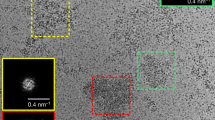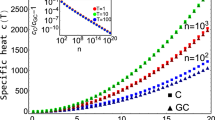Abstract
SICKLE cell haemoglobin (haemoglobin S), which presumably arises from a single mutation at the β-chain locus, differs from normal adult haemoglobin (haemoglobin A) by a replacement of valine for glutamic acid in the sixth position of both β-chains of the haemoglobin molecule1. It has long been known that sickle cell anaemia erythrocytes containing deoxygenated haemoglobin S are birefringent between crossed nicol prisms2,3, and that the mean plane of the porphyrin rings is approximately perpendicular to the long axis of these sickled cells2. Erythrocytes containing haemoglobin A or oxygenated haemoglobin S are not birefringent. Aggregation of deoxygenated haemoglobin S, responsible for birefringence, is the basic mechanism of the sickling phenomenon. The only structural information on the aggregates has been obtained through direct observations with the electron microscope. These have revealed that deoxygenated haemoglobin S molecules in sickled cells4–6 and in cell-free solutions7 lying in parallel arrays form rod-like structures with a diameter ranging from 140 Å to 170 Å.
This is a preview of subscription content, access via your institution
Access options
Subscribe to this journal
Receive 51 print issues and online access
$199.00 per year
only $3.90 per issue
Buy this article
- Purchase on Springer Link
- Instant access to full article PDF
Prices may be subject to local taxes which are calculated during checkout
Similar content being viewed by others
References
Ingram, V. M., Biochim. Biophys. Acta, 36, 402 (1959).
Perutz, M. F., and Mitchison, J. M., Nature, 166, 677 (1950).
Harris, J. W., Proc. Soc. Exp. Biol. Med., 75, 197 (1950).
Bessis, M., Nomarski, G., Thiéry, J. P., and Breton-Gorius, J., Rev. Hematol., 13, 249 (1958).
Döbler, J., and Bertles, J. F., J. Exp. Med., 127, 711 (1968).
White, J. G., Blood, 31, 561 (1968).
Bertles, J. F., Rabinowitz, R., and Döbler, J., Science, 169, 375 (1970).
Dervichian, D. G., Fournet, G., Guinier, A., and Ponder, E., Rev. Hematol., 7, 567 (1952).
Stetson, C. A., J. Exp. Med., 123, 341 (1966).
Dervichian, D. G., Fournet, G., and Guinier, A., CR Acad. Sci., 224, 1848 (1947).
Rand, R. P., and Charache, S., Canad. J. Physiol. Pharmacol., 48, 433 (1970).
Perutz, M. F., Liquori, A. M., and Eirich, F., Nature, 167, 929 (1951).
Muirhead, H., and Perutz, M. F., Nature, 199, 633 (1963).
Author information
Authors and Affiliations
Rights and permissions
About this article
Cite this article
MAGDOFF-FAIRCHILD, B., SWERDLOW, P. & BERTLES, J. Intermolecular Organization of Deoxygenated Sickle Haemoglobin determined by X-ray Diffraction. Nature 239, 217–219 (1972). https://doi.org/10.1038/239217a0
Received:
Issue Date:
DOI: https://doi.org/10.1038/239217a0
This article is cited by
-
5-Hydroxymethylfurfural (HMF) levels in honey and other food products: effects on bees and human health
Chemistry Central Journal (2018)
-
An Optimized Structure-Function Design Principle Underlies Efficient Signaling Dynamics in Neurons
Scientific Reports (2018)
-
Hybrids of Avena sativa with two diploid wild oats (CIav6956) and (CIav7233) resistant to crown rust
Euphytica (2010)
-
The influence of the genotype of Lolium perenne on homoeologous chromosome association in hexaploid Festuca arundinacea
Heredity (1986)
-
Three-dimensional reconstruction of the fibres of sickle cell haemoglobin
Nature (1978)
Comments
By submitting a comment you agree to abide by our Terms and Community Guidelines. If you find something abusive or that does not comply with our terms or guidelines please flag it as inappropriate.



